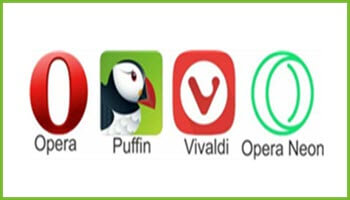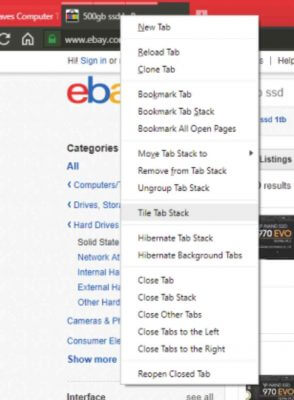This is Part II of the Four Unique Browsers article. Last week we talked about Opera and Opera Neon. This week, we’ll be talking about Vivaldi and Puffin. You can read Part I here.
Vivaldi
Vivaldi, a browser created by one of the founders of Opera, is based on that architecture but manages to be a better browser in almost all aspects.
What I like About Vivaldi
Frankly, almost everything. Vivaldi presents itself as a serious-looking browser with a nice feel and smooth operation. It has the best help system of all the Opera browsers (see below). It also has some neat features not found in any other browser.
Tab Stack
One of the best features of Vivaldi is the smooth operation of Tab Stacks. Simply drag a tab and place it over another tab and when it changes color, release it and the two tabs will be stacked together. Adding three, four, or more is just as easy.
Having the ability to quickly organize tabs is a boost when working on a project or researching something online. You are likely to open more than one web page knowing that they can be organized. It is similar to, but better than Edge’s “set tabs aside” feature. In Vivaldi, the ability to stack tabs comes in handy when you wish to view them side by side.
Tile Tabs
Technically, you do not have to have your tabs stacked to be able to use the Tile Tabs feature, but I find it easier to use the tile feature on stacked tabs.
Once you have several tabs stacked, you can right-click on the stack and choose “Tile Tabs” in the drop-down menu. You can even bookmark the entire stack or remove one or more tabs.
Later, if you wish, you can view each of those tabs side by side by selecting “Tile Tabs” and view those tabs on one page, making comparisons easier to view. You do not have to have tabs stacked to use “Tile Tabs”– just hold the Shift key and select the tabs you would like to tile. Once selected, just right-click on the stack and select Tile Tabs. Unlike most browsers that allow side by side viewing of web pages, Vivaldi lets you tile several tabs — two, three and four are very comfortable — on a regular monitor and eight or more on large or dual monitors is no problem. That may seem like a lot, but being able to view shopping, research, travel sites, etc, can be very useful.
Help
Pressing F1 Opens Vivaldi help:
There is an online help source complete with a Knowledge Base, Forums, Search, plus 12 other sections covering just about everything you need to run this browser efficiently. It even has a Get Started icon to get you running quickly. In addition, the Settings feature is one of the best laid out settings page of any browser I know. Clicking on any of the topics in the left panel opens a right viewing panel defining each topic in a very easy to understand layout. I guess what I find interesting is that it is very similar in its layout and functionality as is selecting File>Options in Microsoft Office, yet Microsoft did not use that same layout in Edge.
Additional Features
The left pane gives you the ability to screen capture, select capture, attach files and to take notes. Because the note feature is easy to access, you can quickly type helpful thoughts while browsing for easy recall. Another unique feature is that clicking on any icon will open a partial image, leaving your current web page open.
Like Opera, you can customize Speed Dial by adding favorites for changing the position of the Dials. You can Sync across all your devices and encrypt your data
What I Don’t Like About Vivaldi
Truthfully, not much. It is a little slow opening but runs smoothly once it is running. Other than that, I am sorry it is not more popular because the work put into this browser should be recognized and supported.
Puffin qualifies as unique by being a crazy-fast cloud-based browser. It processes web pages on cloud servers using encrypted data. They are capable of loading web pages more than 400% faster.
What I Like About Puffin
The Puffin browser does not have a lot of bells and whistles like Vivaldi or any of the more common browsers. The Speed Dial is pretty bland but effective. What it does have in abundance are speed and safety.
Puffin uses a JavaScript engine combined with cloud computing technology that pre-processes and compresses web pages. This process enables them to be displayed incredibly fast. So fast that it claims to be 1600 times faster than Chrome. In addition, because all data is first sent to be encrypted on a cloud server which can filter out any malware or virus, it makes surfing very safe. It is also safe and ideal to use in insecure public WiFi locations.
Because the website you access sees the Puffin Cloud Server’s IP, your IP address is masked. Combined with Incognito mode, it effectively erases 100% of any surfing activity upon exiting. While the speed on a PC is impressive, it is exceptional on mobile devices. I have used Puffin on my Samsung 8 Note with no problems. If you don’t have an unlimited data plan for your phone, I would highly recommend that you consider using Puffin. I can’t vouch for the 85% savings it claims because I have no way of measuring it, but it really is fast. Faster downloads mean fewer data minutes, faster connections make videos and games easier to play.
What I Don’t Like About The Puffin Browser
Sad to say, other than speed and safety, Puffin really has nothing else going for it– no plug-ins, no extra features.
(Disclaimer, the speed test was conducted without the use of ad blockers. Blocking ads on any of the browsers would have increased their speed so even the ad blockers that were built into a browser were disabled for this test.)
Summary
There are certainly a lot more unique or often called “boutique’ browsers out there. This is just a list of four of my favorites. If you do have a limited data plan, I would really recommend you try the Puffin browser to see if it helps save you valuable bandwidth. Also, on just about any browser you use on a phone, I would recommend that you first turn on a quality Ad-blocker, and second, you white-list helpful sites like DCT that actually gives you value along with ads.
Speaking of Ads, my next browser article will be covering a fifth, but I need to spend more time thoroughly going through it. It just might be the direction all browsers have to go in the future, so I want to give it a good shakedown to see if what they claim is possible. Either way, I will report it here.
TOC
- Four Unique Browsers – Part I
- Four Unique Browsers – Part II ← You are here
—



